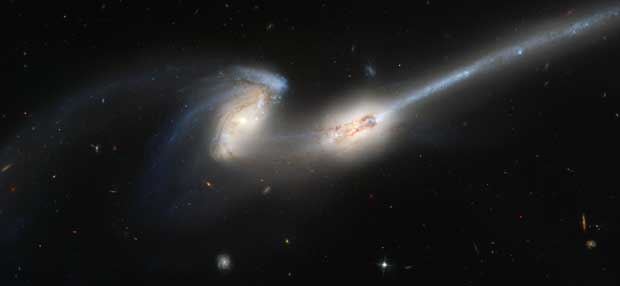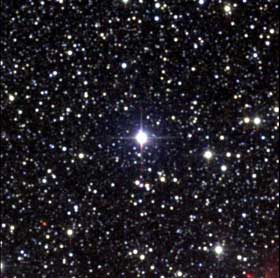Galactic Cannibalism

(NGC 4676, The Mice galaxies. A pair of colliding galaxies. Taken by the Hubble Space Telescope. From http://apod.nasa.gov/apod/ap040612.htmlAPOD, 2004-06-12
Between the northern constellations Cassiopeia and Pegasus, you can distinguish a small, blurry spot in the Andromeda constellation.
This blur, called M31 or the Andromeda Galaxy, is one of the most distant objects that can be seen with the naked eye and it's on a collision course with our home galaxy, the Milky Way.

The Milky Way and Andromeda Galaxies.
In fact, at this very moment we are hurtling towards Andromeda, a behemoth of a galaxy, home to somewhere around a trillion stars. The Milky Way is only 80-percent its size, so the interaction will allow Andromeda to strip the stars from our galaxy and create one super-sized system in a process called galactic cannibalism.
In 1910, astronomer Edwin Hubble was using the Hooker 100 inch telescope atop Mt. Wilson to study the motion of objects in the night sky.
By calculating the radial velocity, he was able to determine that most objects outside our galaxy were redshifted, implying that they were moving away from the Milky Way.
Redshift happens when light from an object is increasing in wavelength, shifting it towards the red end of the light spectrum.
Most importantly for astrophysics, his observations proved that the universe is expanding, but his observations also showed that Andromeda was blue shifted, meaning it was getting ever closer.
That may sound apocalyptic, but from the Earth's perspective, there will be very little action when the galaxies do interact in a distant 4.5 billion years. Of course, life may well have vanished from the planet by that point anyway.

The brightest star is Proxima Centari, the closest star to Earth besides the sun.
Atlas Image (or Atlas Image mosaic) obtained as part of the Two Micron All Sky Survey (2MASS), a joint project of the University of Massachusetts and the Infrared Processing and Analysis Center/California Institute of Technology, funded by the National Aeronautics and Space Administration and the National Science Foundation.
Galactic interactions are a common occurrence as the universe evolves. The Hubble Space Telescope has imaged a number of such interactions. Most galaxies will merge with others in their lifetimes and there's substantial evidence to indicate both systems have joined up with others over the eons.
In around two billion years, Andromeda and the Milky Way will fly past each other, setting the process in motion.
The fly-by will drag out a long tail of stars from each of the galaxies before the two whip back around and mash together, forming one bulbous elliptical galaxy instead of the classic spiral form both now have. The resulting galaxy will dwarf the dozens of others in our cosmic neighborhood.
The chances of a collision with Proxima Centari, the sun's closest neighbor, are remote because of the vast distances involved. The star is more than four light years away.
So even with unimaginable billions of possible collisions, the chances of any particular one occurring is slight.
The addition of a trillion stars to the system will likely push the sun, which currently sits at the outer reaches of the Milky Way, deep into the heart of the new system.
Based on computer simulations, there is a one-in-ten chance that our solar system will be evicted from the galaxy in the process, but even that would have little impact on life on Earth other than a dramatically altered night sky. The orbits of the planets and moons of our solar system wouldn't notice the difference.
If the sun were to be thrown from the galactic suburbs and into the unoccupied regions of space, the bright region of night sky we call the Milky Way would vanish. The thousands of points of light from our neighbors would also disappear, leaving the night sky far darker.
If the sun were to instead end up closer to the center of the new galaxy, it would fill the night sky with new stars.
So next time you stargaze, look to Andromeda and ponder the havoc that tiny blur will one day wreak on the galaxy. If nothing else, it should make life more difficult for astrologers.
For more info:
http://www.newscientist.com/article/dn11852
http://arxiv.org/PS_cache/arxiv/pdf/0705/0705.1170v1.pdf
http://hubblesite.org/newscenter/archive/releases/2008/16/video/a/
http://www.nasa.gov/audience/forstudents/5-8/features/F_When_Gallaxies_Collide.html














